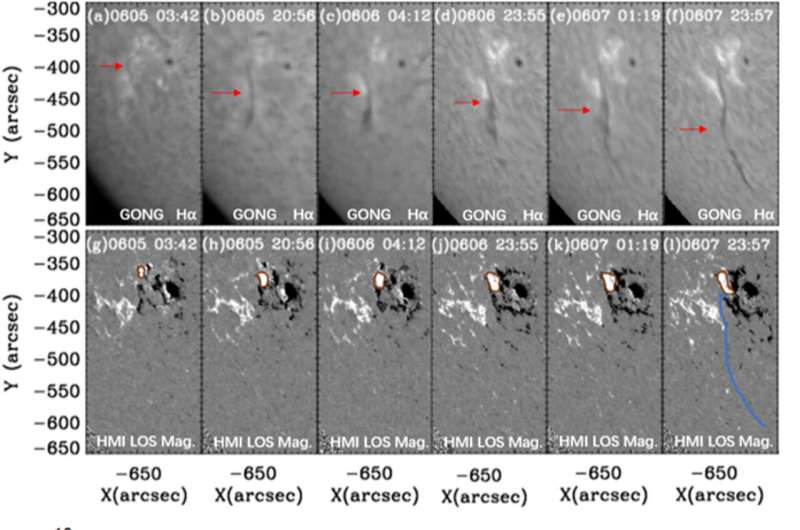The process of filament formation. (a)–(f) GONG Hα images. The growing filament is marked by the red arrows. (g)–(l) The corresponding HMI magnetograms. The brown solid curves represent the position of magnetic emergence. The blue line in panel (l) outlines the position of the filament. (m) The evolution of the projected area of the filament. The start time was 2020 June 5 at 03:10 UT. The red dotted line, pink solid line, and green solid line represent the starting time of the material injection in each time period, the first linear growth and the second linear growth, respectively. Credit: The Astrophysical Journal (2023). DOI: 10.3847/1538-4357/acaa3e
Researchers led by Yan Xiaoli from the Yunnan Observatories of the Chinese Academy of Sciences, in collaboration with Sun Xia and Liang Hongfei from Yunnan Normal University, have clearly observed the formation of an intermediate solar filament caused by small-scale oscillation magnetic reconnection.
The study was published in The Astrophysical Journal on Feb. 22.
Magnetic reconnection is a physical process of converting magnetic energy into kinetic and thermal energy, which can change the topology of magnetic field.
Many observational instances of magnetic reconnection have been reported, such as current sheets, bright cusp-shaped structures, plasma inflow/outflow, and so on. However, direct observations of magnetic reconnection leading to the formation of filament are still very rare.
Using high-resolution data from the 1-meter New Vacuum Solar Telescope (NVST) at the Fuxian Lake Solar Observatory, the extreme ultraviolet (EUV) data from the Solar Dynamics Observatory (SDO) and the Global Oscillation Network Group (GONG) data, the researchers analyzed the filament formation caused by small-scale magnetic reconnection that occurred in the active region 12765 on June 5, 2020.
They found that the filament and the surrounding magnetic loops were in close proximity to each other, followed by magnetic reconnection between them.
"The formed current sheets were almost relatively perpendicular current sheets, called oscillatory reconnection. The plasma was injected into the interior of the filament, leading to the formation of the filament," said Yan, corresponding author of the study.
Moreover, the researchers calculated the physical quantities such as the velocity, mass, and kinetic energy of the material entering the filament. They found that the injected mass from the magnetic reconnection was consistent with the estimated mass of the filament.
More information: Xia Sun et al, Formation of an Intermediate Filament Driven by Small-scale Magnetic Reconnection, The Astrophysical Journal (2023). DOI: 10.3847/1538-4357/acaa3e
Journal information: Astrophysical Journal
Provided by Chinese Academy of Sciences
























